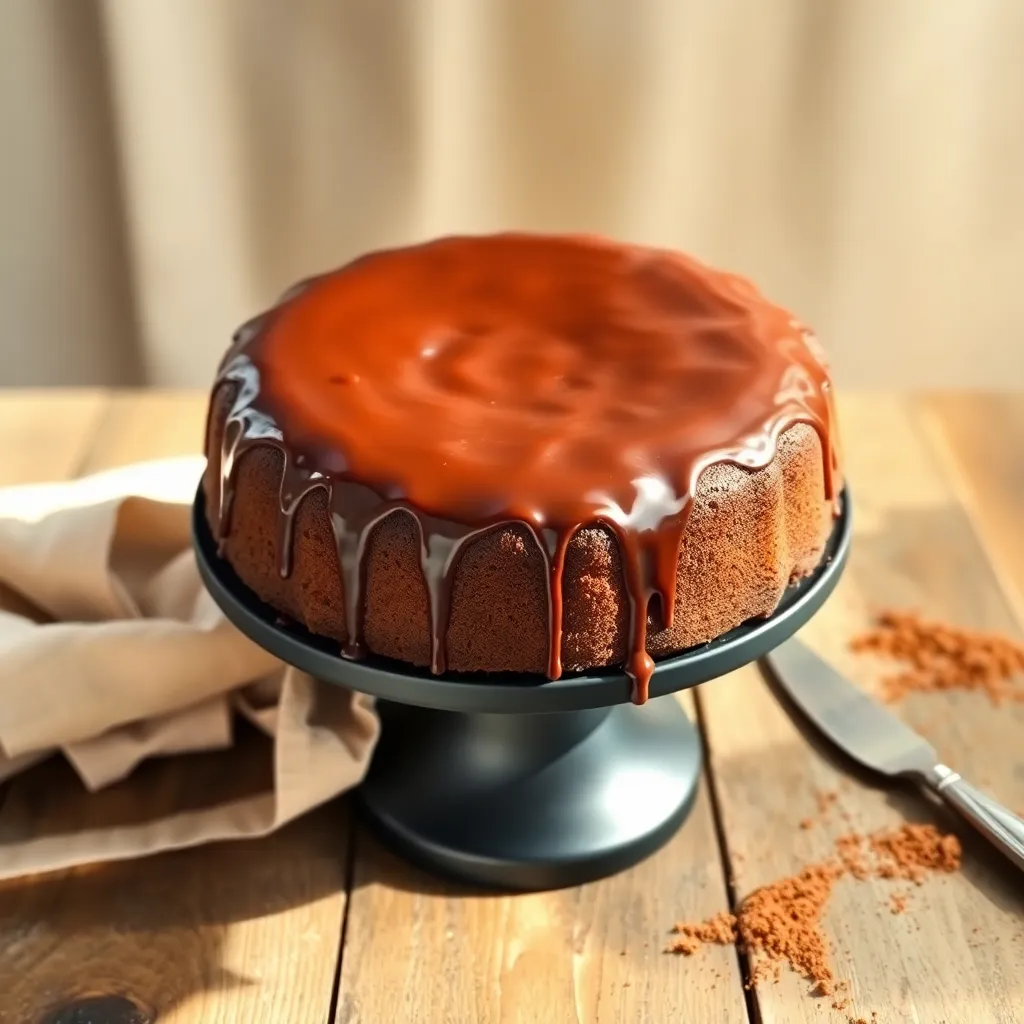Buttermilk Chocolate Pound Cake is not just cake, it’s memory baked into form. I remember the first time I pulled one from the oven—my grandmother’s old cast iron loaf pan rattling on the rack, that aroma of cocoa and butter spilling out like a secret too big to keep. It’s the kind of cake that doesn’t whisper sweetness but sings it, rich and dark yet softened by the tang of buttermilk. You don’t slice this cake, you carve it, almost reverent.
Buttermilk Chocolate Pound Cake is special because of the alchemy between fat, acid, and sugar. The buttermilk works behind the scenes, loosening the tight crumb you’d expect from a pound cake, giving it tenderness without collapse. The cocoa, when paired with buttermilk, tastes almost deeper—less flat, more like chocolate should taste when it’s honest. And that crust, oh that crust, caramel-dark, crackly, hiding the moist heart inside.
Ingredients & Substitutions
Buttermilk Chocolate Pound Cake begins with flour, the skeleton of the whole affair. All-purpose flour does the job beautifully, though cake flour can make it feel softer, almost like velvet when it brushes against the tongue. I usually stick with all-purpose for a bit more structure—sliceable, but never tough.
Buttermilk Chocolate Pound Cake demands real cocoa, not the dusty can that’s been lurking in the pantry for two years. Dutch-process cocoa makes it darker, smoother, almost fudgy. Natural cocoa gives a sharper edge, a little tang that pairs cheekily with the buttermilk. Both work, but Dutch-process feels a touch more luxurious.
Buttermilk Chocolate Pound Cake wouldn’t be itself without butter. Good butter. Unsalted, high-fat if you can manage, because this is the main flavor carrier. Margarine has no business here. Oil? Maybe, but only if you’re chasing a softer, lighter cake at the expense of flavor depth.
Buttermilk Chocolate Pound Cake can handle sugar swaps if you’re adventurous. White granulated sugar is standard, but half brown sugar adds molasses depth, almost caramel notes. Honey or maple syrup would ruin the texture, so avoid.
Buttermilk Chocolate Pound Cake needs eggs, not substitutes if you can help it. They bind, lift, emulsify. If allergies demand, a flax egg could work, but the crumb won’t feel the same.
Buttermilk Chocolate Pound Cake requires actual buttermilk, not just milk with a squeeze of lemon. The cultured tang is different—thicker, more complex, balancing the cocoa’s richness. In a pinch, kefir or thinned yogurt steps in with grace.
Step-by-Step Instructions
Buttermilk Chocolate Pound Cake starts with creaming butter and sugar. Don’t rush this. Air needs to be beaten into fat until it looks pale, like whipped sunshine. Under-creaming means a dense, gummy loaf.
Buttermilk Chocolate Pound Cake then welcomes the eggs, one at a time. Drop them in too fast, and the batter breaks, looks like cottage cheese. Patience solves it—room temperature eggs, slow incorporation, and the mix stays silky.
Buttermilk Chocolate Pound Cake turns chocolatey when the sifted cocoa and flour enter the mix. Sifting is not optional. Cocoa clumps are stubborn, like bitter pockets if left unscreened. Mix gently, because overbeating here builds gluten, toughening the crumb.
Buttermilk Chocolate Pound Cake folds in buttermilk last. Alternating wet and dry additions keeps the batter smooth. Pouring all the buttermilk at once floods the batter, breaking the emulsion. Dry-wet-dry-wet-dry is the rhythm you want.
Buttermilk Chocolate Pound Cake bakes low and slow, 325°F usually. High heat scorches the cocoa and hardens the crust before the inside sets. A toothpick test at 60 minutes helps, though ovens differ—sometimes 75 minutes, sometimes less. What you want is moist crumbs, not wet batter clinging.
Buttermilk Chocolate Pound Cake rests in its pan 10 minutes before unmolding. Too soon, and it collapses into pieces. Too late, and it sticks to the sides, tearing the crust. The sweet spot is when the pan feels just cool enough to handle but still warm.
Cooking Techniques & Science
Buttermilk Chocolate Pound Cake depends on acid-base chemistry. Buttermilk’s acidity reacts with baking soda, releasing carbon dioxide. That’s lift. Without it, the cake would sit heavy like clay. Professionals know balance matters—too much soda, and the cake tastes soapy; too little, and the crumb feels leaden.
Buttermilk Chocolate Pound Cake illustrates the Maillard reaction beautifully. The butter, sugar, and cocoa at the crust caramelize under slow heat. That’s why you get the nearly bittersweet edges, contrasting the soft interior. Science and flavor holding hands.
Buttermilk Chocolate Pound Cake benefits from the right tools. A heavy loaf pan bakes evenly, preventing burnt edges with raw centers. Nonstick works, but a buttered-and-floured metal pan wins—better crust, cleaner release.
Buttermilk Chocolate Pound Cake turns richer with resting. Like stews and braises, it tastes better a day later. The cocoa blooms overnight, moisture redistributes, crumb tightens just right. Wrap it snug in plastic, and resist the temptation for twelve hours if you can.
Serving & Pairing Suggestions
Buttermilk Chocolate Pound Cake doesn’t need icing, though it wears one well. A drizzle of ganache makes it dessert-slick, glossy as midnight. A dust of powdered sugar feels old-fashioned but elegant, like Sunday teas in old films.
Buttermilk Chocolate Pound Cake pairs beautifully with coffee. Black espresso cuts the richness, each sip scraping the tongue clean for the next bite. Cold milk is another story—classic, comforting, the kind of pairing that makes you forget fancy plating.
Buttermilk Chocolate Pound Cake slices beautifully for layered presentations. You can stack it with whipped cream and berries, almost like a trifle. Or cube it into parfait glasses with mascarpone and cherries for a Black Forest nod.
Buttermilk Chocolate Pound Cake serves as a base for innovation. Toast a slice in butter, top with salted caramel, and it shifts from humble loaf to restaurant-level dessert. Grill it briefly, and the sugars blister, deepening the cocoa. Few cakes can take that kind of treatment and come out stronger.
Conclusion
Buttermilk Chocolate Pound Cake is more than a recipe. It’s a lesson in balance—fat with acid, bitter with sweet, crust with crumb. The kind of cake that rewards patience, precision, and care, yet forgives small missteps.
Buttermilk Chocolate Pound Cake matters because it proves chocolate cake doesn’t have to be flashy. It can be quiet, steady, deeply satisfying without frosting towers or sprinkles. Just butter, sugar, cocoa, and buttermilk doing their dance.
Buttermilk Chocolate Pound Cake, in the end, is a baker’s secret weapon. A cake that keeps well, travels well, slices clean, and tastes even better on day two. Make it once, and you’ll find reasons to make it again.
FAQs
Why is buttermilk important in chocolate pound cake?
Buttermilk adds acidity, which tenderizes gluten and reacts with baking soda for lift. It also deepens the cocoa flavor, giving it more complexity.
Can I use regular milk instead of buttermilk?
Regular milk with lemon juice or vinegar works in a pinch, but cultured buttermilk gives better texture and taste. Yogurt or kefir are closer substitutes.
How do I prevent my pound cake from drying out?
Avoid overbaking, and let it rest covered once cooled. The cake keeps best wrapped tightly, and it tastes even more moist after resting overnight.
What’s the best cocoa for this recipe?
Dutch-process cocoa gives a darker, smoother flavor, while natural cocoa makes it brighter and tangier. Both work, but choose based on preference.
Can I freeze buttermilk chocolate pound cake?
Yes. Wrap slices in plastic and freeze up to three months. Thaw at room temperature or warm slightly for best results.

Olivia P. is a seasoned food blogger at Tastywink, sharing delicious, easy-to-follow recipes inspired by him passion for home cooking. With years of culinary blogging experience, he brings flavor, creativity, and a personal touch to every dish.
